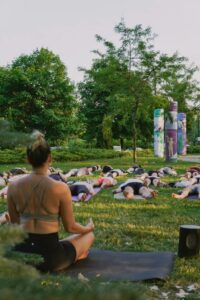The Power of Daily Meditation
Meditation isn’t just about sitting cross-legged in silence for hours—it’s a practice that can be woven into your everyday life, offering profound benefits for both your mind and body. In today’s fast-paced world, it’s easy to feel overwhelmed by the constant buzz of responsibilities, deadlines, and distractions. That’s where meditation can make a huge difference. Whether you’re looking to reduce stress, boost focus, or simply find a sense of peace, incorporating even a small amount of meditation into your daily routine can yield incredible benefits.
Tips for Getting Started with Daily Meditation
Starting a new practice can feel intimidating, especially when there’s so much information available on the topic. But meditation doesn’t have to be complicated or time-consuming. Here are some simple tips to help you get started and build a sustainable practice:
1. Start Small and Build Gradually
If you’re new to meditation, it’s important to start small and work your way up. There is no need to rush into these elaborate yoga poses for an hour a day. Start where your body feels comfortable, and you can grow each time. Even just 5 minutes each day, you will become more comfortable. The goal isn’t to push yourself into long sessions but to establish a habit that fits your lifestyle. Even short bursts of meditation can have a positive impact.
2. Be Consistent
The most important part of meditation is consistency. The benefits of meditation accumulate over time, so it’s crucial to make it a daily habit. Find a time that works for you, whether it’s first thing in the morning, during lunch, or before bed. Just make sure to stick with it. Like any skill, the more you practice, the better you’ll get. So, consistency is key to making meditation a valuable part of your life.

3. Incorporate Gentle Movement
Meditation and movement don’t have to be mutually exclusive. Many people find that incorporating light stretching or yoga into their meditation practice can help to release tension and allow the body to relax. If you’re someone who struggles to sit still for long periods, try doing some gentle stretches before or during your meditation. These small movements will help prepare your body and mind to settle into a more relaxed state.
4. Use Guided Meditation Apps or Resources
It’s not necessary to meditate alone, especially when you’re just getting started. There are a variety of apps and online resources that can provide guidance and structure, making meditation feel more approachable. Whether it’s an app or following a video on YouTube, there are plenty of options to guide you through your sessions. If you’re feeling lost or unsure, a guided meditation can give you the structure and reassurance you need.
5. Find a Quiet, Peaceful Space
One of the most important factors in meditation is creating the right environment. Choose a space that’s free from distractions and noise. I prefer to meditate in the early morning when the world is still quiet, and the body is naturally in a state of rest. However, if mornings aren’t your thing, try to find another time during the day when you can have a peaceful moment to yourself. A calm space will help you focus and allow you to fully immerse yourself in the experience.
Alternatives to Traditional Meditation
Not everyone finds traditional sitting meditation appealing, and that’s okay! If you prefer something different, several alternative practices can provide similar benefits. Here are a few ideas:
1. Walking Meditation
Walking meditation involves mindfully walking at a slow, deliberate pace, paying attention to the sensations in your body and your surroundings. This practice can be done anywhere, from a quiet park to your own backyard. Walking without distractions, such as music or a phone, can be a wonderful way to clear your mind and get some light exercise at the same time.
2. Adult Coloring Books
If you find that sitting still is difficult, try using an adult coloring book. Many people find that coloring intricate patterns can help them relax and enter a meditative state. Coloring can be a great way to focus on the present moment and reduce stress, and it’s also a fun and creative outlet.
3. Prioritize Sleep
Sleep is a vital component of overall health and well-being, and it’s often overlooked in discussions about self-care. Good quality sleep can have a meditative effect on your body, helping to restore energy and clear your mind. If you find yourself feeling exhausted or mentally foggy, take a step back and listen to your body. You might need more rest than you’re getting.
Conclusion
Meditation doesn’t need to be complicated or take up a lot of time to be effective. Whether you’re stretching, walking, coloring, or simply focusing on your breath, there are plenty of ways to practice mindfulness and meditation each day. The key is to start small, stay consistent, and find what works best for you. Over time, these small moments of peace and clarity can have a lasting impact on your overall health in your everyday life.
Check out our last blog post here



